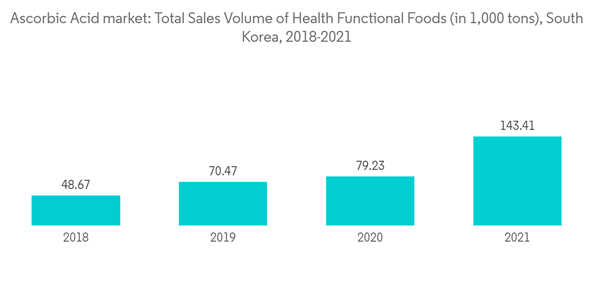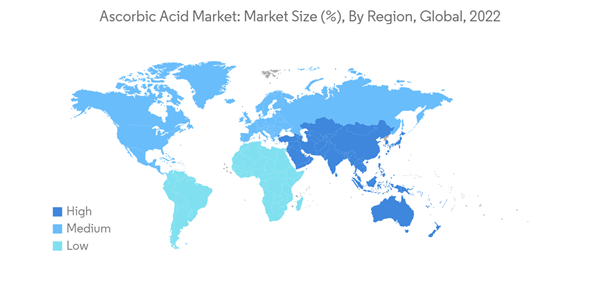The Ascorbic Acid Market size is estimated at USD 1.97 billion in 2024, and is expected to reach USD 2.58 billion by 2029, growing at a CAGR of 5.66% during the forecast period (2024-2029).
Ascorbic acid is a water-soluble vitamin that is effective for patients with critical illnesses. Ascorbic acid is primarily synthesized for use as an antioxidant. Ascorbic acid is primarily used in the pharmaceutical, food and beverage, personal care, and other end-user industries. The major ascorbic acid consumption is the pharmaceutical industry. Vitamin C aids in Vitamin E recycling. The rest is primarily used as an addition to food and feed to improve the quality and stability of the final product. Foods with ascorbic acid added protect their color, flavor, and nutritional value during manufacturing or before packing. The use of ascorbic acid in the food & beverages industry is anticipated to increase during the forecast period. The market has been witnessing growth in China due to the high production volume of Vitamin C in the country. The country holds high power in setting the global prices of the ingredient, which is a major factor driving the market. The increasing usage of Vitamin C in cosmetics and personal care products has added to the growth of the ascorbic acid market. The paradigm shift from clean-label food and beverage products to dietary supplements has led to the emergence of many manufacturers offering clean-labeled vitamin C supplements to consumers seeking antioxidant support for immune health through supplements. As a result, the demand for ascorbic acid has increased in the pharmaceutical and healthcare industry.
Global demand for functional foods and beverages is a significant driver of the ascorbic acid market. Additionally, new production methods, innovative technologies, and a significant increase in investments in Research and development activities are the other elements anticipated to support the expansion of the ascorbic acid market. Another factor driving the expansion of natural ascorbic acid regulators is the surge in demand for stabilizers and antioxidant food ingredients across European nations to produce commercialized clean label or green food products that are free of additives and other dangerous chemicals. Manufacturers can now create new flavors to meet the shifting preferences of their customers due to advances in technology. Innovative and original flavors in food are produced by the use of modern technologies.
This product will be delivered within 2 business days.
Ascorbic acid is a water-soluble vitamin that is effective for patients with critical illnesses. Ascorbic acid is primarily synthesized for use as an antioxidant. Ascorbic acid is primarily used in the pharmaceutical, food and beverage, personal care, and other end-user industries. The major ascorbic acid consumption is the pharmaceutical industry. Vitamin C aids in Vitamin E recycling. The rest is primarily used as an addition to food and feed to improve the quality and stability of the final product. Foods with ascorbic acid added protect their color, flavor, and nutritional value during manufacturing or before packing. The use of ascorbic acid in the food & beverages industry is anticipated to increase during the forecast period. The market has been witnessing growth in China due to the high production volume of Vitamin C in the country. The country holds high power in setting the global prices of the ingredient, which is a major factor driving the market. The increasing usage of Vitamin C in cosmetics and personal care products has added to the growth of the ascorbic acid market. The paradigm shift from clean-label food and beverage products to dietary supplements has led to the emergence of many manufacturers offering clean-labeled vitamin C supplements to consumers seeking antioxidant support for immune health through supplements. As a result, the demand for ascorbic acid has increased in the pharmaceutical and healthcare industry.
Global demand for functional foods and beverages is a significant driver of the ascorbic acid market. Additionally, new production methods, innovative technologies, and a significant increase in investments in Research and development activities are the other elements anticipated to support the expansion of the ascorbic acid market. Another factor driving the expansion of natural ascorbic acid regulators is the surge in demand for stabilizers and antioxidant food ingredients across European nations to produce commercialized clean label or green food products that are free of additives and other dangerous chemicals. Manufacturers can now create new flavors to meet the shifting preferences of their customers due to advances in technology. Innovative and original flavors in food are produced by the use of modern technologies.
Ascorbic Acid Market Trends
Increasing Demand from Fortified/Functional Food and Beverage Application
With the rising number of health-conscious individuals, the demand for fortified food and beverage is also increasing. Consumers, primarily in developed and developing countries like the United States, India, China, and Germany, are increasingly reaching for nutrient-based and other products containing functional ingredients to ward off illnesses or help with existing health issues. Ascorbic acids are vital ingredients used in functional food & beverage products. Due to its extensive range of applications as a preservative, flavoring agent, taste enhancer, or taste modifier in confectionery, sauces, bread, and other products, they are anticipated to have significant expansion in the future. The demand for fortified beverages and other foods and beverages is also rising, which supports the growth of the ascorbic acid market. Since more people are becoming aware of ascorbic acid's advantages, it is anticipated that the impact of these drivers will increase dramatically. The demand for fortified food and beverage has led companies to incorporate ascorbic acid into their products. For instance, in 2021, Krating Daeng, a brand of TCH Group, collaborated with DHC, the leading food supplement producer in Japan, catering to the Vitamin C demand in Thailand. Also, various government initiatives are being taken to increase the consumption of fortified food and beverages, especially in developing countries like China and India. For instance, China's Ministry of Health promotes the intake of fortified food due to growing health concerns relating to age, myopia, and other diseases, thus driving the demand for ascorbic acid in the region.Asia-Pacific Emerges as the Largest Market
The consumption of ascorbic acid in Asian countries, primarily in India, China, and Japan, is expected to grow rapidly due to the cost-effective manufacturing facilities in these countries. This factor has paved the way for manufacturers to penetrate the functional food and beverage sector with innovative bioactive ingredients, including ascorbic acid. The growing demand for health and dietary supplements in the region is also expected to fuel the market's growth over the forecast period. Deficiencies of significant micronutrients like iodine, Vitamins A and C, iron, folate, and zinc are prevalent in Asian countries, making the region a lucrative market for Vitamin C manufacturers and suppliers worldwide. The region is witnessing growth in personal disposable income and supportive government policies, adding to the growing demand. The growth of the pharmaceutical industry is prominent in the regional market, which drives the demand for ascorbic acid. For instance, according to the India Brand Equity Foundation, the Indian pharmaceutical market grew from 13.7% in July 2020 to 17.7% in August 2021.Ascorbic Acid Industry Overview
The ascorbic acid market is highly fragmented, with an increasing number of local and regional players worldwide. Key players like Merck KGaA, Koninklijke DSM NV, Shandong Luwei Pharmaceutical Co Ltd, and Northeast Pharmaceutical Group Co. Ltd cater to a majority of the market. The companies are utilizing their products and technological skills to develop marketing and business strategies across the vitamin and mineral supplements segment, driving innovations, stimulating new product developments, and business planning and branding across social media platforms.Additional Benefits:
- The market estimate (ME) sheet in Excel format
- 3 months of analyst support
This product will be delivered within 2 business days.
Table of Contents
1 INTRODUCTION
4 MARKET DYNAMICS
5 MARKET SEGMENTATION
6 COMPETITIVE LANDSCAPE
Companies Mentioned (Partial List)
A selection of companies mentioned in this report includes, but is not limited to:
- BASF SE
- Merck KGaA
- Koninklijke DSM NV
- Northeast Pharmaceutical Group Co. Ltd
- Foodchem International Corporation
- Honson Pharmatech Group
- MC Biotec Inc.
- Freshine Chem
- CSPC Pharmaceutical Group
- Shandong Luwei Pharmaceutical Co Ltd
Methodology

LOADING...










